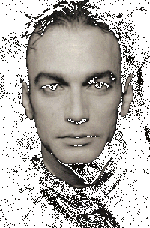

![]() After a series of technological investigations, Costis
achieved the production of lightning from high voltage current. Playing the major role in
his work, this lightning is programmed to appear and disappear, to flash and then fall
silent.
After a series of technological investigations, Costis
achieved the production of lightning from high voltage current. Playing the major role in
his work, this lightning is programmed to appear and disappear, to flash and then fall
silent.
![]() Upon entering the exhibition space, we find
ourselves inside an audio and visual field. The sounds are more or less sustained,
protracted, with an isotonic base and numerous staccatos. The orchestration of the sounds
is accelerated with the setting of a timer switch. Energy sculpture, endlessly variable,
demanding - Costis' work amazes and seduces the eye.
Upon entering the exhibition space, we find
ourselves inside an audio and visual field. The sounds are more or less sustained,
protracted, with an isotonic base and numerous staccatos. The orchestration of the sounds
is accelerated with the setting of a timer switch. Energy sculpture, endlessly variable,
demanding - Costis' work amazes and seduces the eye.
![]() In a 1994 interview with Jacques Donguy, the
theoretician of Fluxus and visual poetry, Costis spoke of the first appearance of
lightning in his sculpture: "The first time I showed lightning was in 1989. And
this was a sculpture called "Vision": the viewer was reflected in a concave
mirror where lightning provided its flash. Parallel to that, I also showed an installation
entitled 'No Man's Land: Ritual of the Explosion.' The lightning was driven through
commonplace objects, as well as lava, coal, granite, and the vital lead ended in the
explosion."
In a 1994 interview with Jacques Donguy, the
theoretician of Fluxus and visual poetry, Costis spoke of the first appearance of
lightning in his sculpture: "The first time I showed lightning was in 1989. And
this was a sculpture called "Vision": the viewer was reflected in a concave
mirror where lightning provided its flash. Parallel to that, I also showed an installation
entitled 'No Man's Land: Ritual of the Explosion.' The lightning was driven through
commonplace objects, as well as lava, coal, granite, and the vital lead ended in the
explosion."
![]() Responding in the same interview to the question of
whether "there are many things to say about the bond between lightning and
electricity, notably in relation to those arts linked to new technologies,"
Costis defines the relationship between myth and technology: "The world of
technology, the electronic era, contains as many myths as do more ancient societies. From
one century to another, mythological baggage has traveled like a secret for survival that
now reaches us with an artificial logic in the same context."
Responding in the same interview to the question of
whether "there are many things to say about the bond between lightning and
electricity, notably in relation to those arts linked to new technologies,"
Costis defines the relationship between myth and technology: "The world of
technology, the electronic era, contains as many myths as do more ancient societies. From
one century to another, mythological baggage has traveled like a secret for survival that
now reaches us with an artificial logic in the same context."
![]() "His work is a meditation upon nature and
light. Lightning, having become a poetic medium, permits the work to become integrated
into the sensorial field as well as the mythological and philosophical,"
writes Xanthippi Skarpia-Heupel, President of the Macedonian Museum of Contemporary Art.
"His work is a meditation upon nature and
light. Lightning, having become a poetic medium, permits the work to become integrated
into the sensorial field as well as the mythological and philosophical,"
writes Xanthippi Skarpia-Heupel, President of the Macedonian Museum of Contemporary Art.
![]() "He reduces the heavenly phenomenon to
the microcosm and the dimensions of man, not to proclaim it a ghastly symbol as primitive
man would have done, but to propose a new relationship among nature, art, and technology,"
states art critic Anna Hatziyannaki.
"He reduces the heavenly phenomenon to
the microcosm and the dimensions of man, not to proclaim it a ghastly symbol as primitive
man would have done, but to propose a new relationship among nature, art, and technology,"
states art critic Anna Hatziyannaki.
![]() The well-known art critic Pierre Restany, who
characterizes Costis as "Promethean," writes at one point in his lengthy
discourse on the artist's work: "Costis' enterprise is presented indeed as an
exposition of philosophical objects, whose presence has as an ultimate justification the
fact - at once simple and formidable - that it incites us to reflect on the dual valence
of alchemical fire. A way of making us witness the permanent victory of life over death
and of light over the ashes of darkness."
The well-known art critic Pierre Restany, who
characterizes Costis as "Promethean," writes at one point in his lengthy
discourse on the artist's work: "Costis' enterprise is presented indeed as an
exposition of philosophical objects, whose presence has as an ultimate justification the
fact - at once simple and formidable - that it incites us to reflect on the dual valence
of alchemical fire. A way of making us witness the permanent victory of life over death
and of light over the ashes of darkness."
(Translation from the Greek and French: Andrea Gilbert)